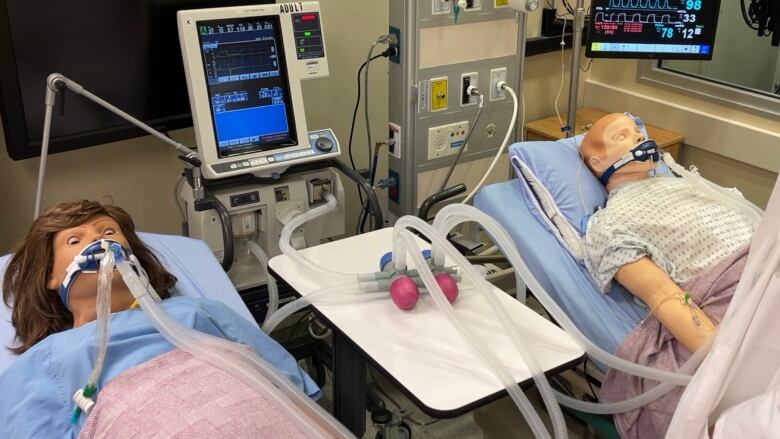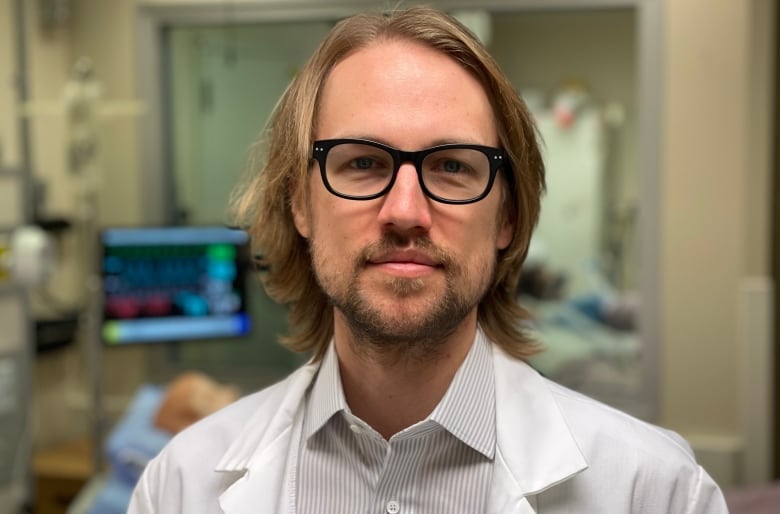Calgary doctor's ventilator innovation could be a game changer in future emergencies
Device inspired by pandemic allows four people to share a single ventilator

It started with lots of late nights in Dr.Steven Roy's garage.
The critical care medicine fellow at the University of Calgary startedbuilding a rough version of a devicein-betweenlongshifts at work, usingpieces of PVC vacuum tubing and fittings sealed with glue.
"At the beginning of the pandemic, there wereconcerns about an impending ventilator shortage, and people started talking about dividing a ventilator between multiple patients," said Roy.
"I realized there was a way to make it safe for patients."
A ventilator is a machine that pumps and regulatesair inand out of the lungs, helping patients whocan't breathe on their own.
When COVID-19hit,many ventilators stockpiled in storage around the world hadn't been maintained over the years andcouldn't be used. Other countries didn't have many to begin with.
Roy got to work on a system that would, in emergency situations,allow up to fourpatientsto receive different amounts of air from a single ventilator usingadjustable plastic taps to control air flows.
Similar ventilator splittershave been manufactured and even been used already in severalcountries during the pandemic, but most devices allowonlytwo patients to share a ventilator.

"It was literally nuts and bolts and tubing from the hardware store," he said. "I would finish a 24-hour shift and go home and work on it in my garage."
Thework wasfunded withmoney from Roy's salary along with apartnership with local 3D printing and design companyExergySolutions.
Roy, who isalso the founder ofamedical startup called Convergence Medical Sciences,realized taking hisinvention to the next level could make itviable commercially both in Canada and internationally.
He manufactureda functional 3D-printed prototype model of his creation,called theValence InVent Xtend, which hasnow been approved andlicensed by Health Canada under the COVID-19 Interim Order and could be used on patients in the future.
He says the low-costplastic device has applications beyond the pandemic.
"There are different uses for it. One is in humanitarian settings like a field hospital or in African countries that already had ventilator shortages before COVID."
Ventilatorscost up to $70,000 per unit. Roy's device costs around $50 per patient andneedslittle to no maintenance.
"There are specific clinical indications for a device like this, like when a patient has a leak around the lung, it might be a time to use this. It can also be used in planning for disasters, when a train derails or there's a mass casualty event of another kind. This device allows an emergency room or a hospital to have a plan for when ventilators are suddenly needed to increase supply temporarily."

The University of Calgary hasbeeninvolved inresearching the conceptand mechanicsbehind the device, bringing engineers and doctors together,but it isn'tinvolved in the commercial development of the patented prototype.
Dr. Jihyun Lee is anassistant professor in the department of mechanical and manufacturing engineering at the university's Schulich School of Engineering. Lee worked with Roy alongside a small engineering team, including graduate students,to evaluate the physics and engineering side of his idea. They focused on monitoringthe air dynamics inside the ventilator system.
"Weneeded to understand the inside, how the air flow moves from the ventilator to the patients and how much time delay happens," said Lee.
"This opportunity came to me because of COVID, it's not a usual collaboration," she said.
Lee says her team has been working on the project for a year-and-a-half.
Roy says his invention has already attracted severalawards.
"We've been honoured with some awards, including the international design excellence award, which has been given in the past to Apple and Tesla, so getting that kind of awardis validation."
Roy says hisValenceInVentXtend has been added to the permanent collection of the Henry Ford Museum for American Innovation.












_(720p).jpg)


 OFFICIAL HD MUSIC VIDEO.jpg)
.jpg)



























































































